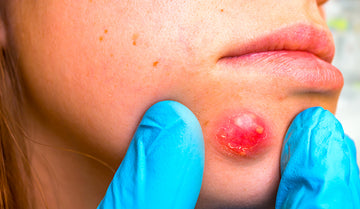BOILS

The Best Boil Treatment for Infection Prevention

A boil is a contagious skin infection that starts in a hair follicle or oil gland. Most of the time, boils are caused by the bacteria Staphylococcus aureus (Staph). However, boils can also take form from other types of bacteria or fungi on your skin. You may get boils just once, every once in a while, or at times, quite often.
At first, the skin will turn red in the area of the infection, and a tender lump develops. After about 4 to 7 days or so, the lump will start turning white as pus continues to collect under the skin. When you know how to get rid of a boil, you can probably treat it at home with various natural remedies, or a topical antibiotic like Vitastem Ultra.
Boils can affect any area of your body where you have hair, or where rubbing can occur. Typically, boils will usually take form in places where you sweat.
Here are some common places they can appear:
The Groin Area. Boils can affect the skin folds of the groin, the pubic area, and the lips and folds of the vagina. The groin area has a lot of hair follicles and can be prone to chafing, especially if you wear tight-fitting underwear and clothes. If you get a cut or ingrown hair in your grown area due to shaving, you may also end up developing a boil.
The Buttocks. Due to the amount of hair follicles, sweat, oils, and friction that affects this area of the body, boils will frequently be a result of this. In addition, dirty underwear can make a boil more likely to appear here too.
The Face. Although boils on your face look similar to cysts and pimples, they are quite different. Cysts are filled with fluid, while pimples are the end result of a clogged pores. Cysts and pimples aren’t contagious, however, boils can be.
Eyelids. If a boil occurs on your eye, it’s called a stye, and it can be quite painful too. You can treat these ones similarly to the way you treat a boil anywhere else on your body. If the boil doesn’t go away on its own, a dermatologist can recommend using a topical antibiotic like Vitastem Ultra or eye drops.
Other areas where boils often appear include:
- Breasts
- Armpits
- Shoulders
- Legs
Note: If you see a boil appear in a group, that’s a more serious type of skin infection called a carbuncle.
What Causes Boils?
Most often, boils are caused by staph bacteria. This germ can enters one’s body through tiny nicks or cuts in your skin, or it can travel down a hair to the follicle.
These things below make people more susceptible to getting boils:
- A weak immune system
- Diabetes – this can make it harder for your body to fight off infection
- Other skin conditions (ones that break your skin’s protective barrier)
- Contact with others (especially if someone you live with has a boil)
- Poor hygiene
- Poor nutrition
- Exposure to harsh chemical that may irritate your skin
Common Symptoms of Boils
A boil will often start out as a red, hard, painful lump that is about the size of a pea. Within a few day, that lump becomes softer, larger, and more painful. Soon a pocket of pus will form on the top of the boil.
These are common signs of a serious infection:
- Fever
- Swollen lymph nodes
- Infected, red, painful, and warm skin around the boil
- Additional boil or boils
When to Seek Medical Care for Boils
Boils usually don’t require any medical attention. But if you’re in poor health and develop a high fever and chills along with the boil, then you might need go to urgent care or possibly the emergency room.
Call your doctor if your boil doesn’t go away after 2 weeks or or you have:
- Fever
- Swollen lymph nodes
- Red or red streaks around the boil
- Serious pain
- Multiple boils
- Vision issues
- Recurring boils
- Other conditions such as a heart murmur, diabetes, a problem with your immune system, or if you use immune-suppressing drugs like corticosteroids or chemotherapy
Boils Treatment: Common Home Remedies
Most of the time, you or a loved one should be able to treat boils at home. But whatever you do, don’t pick at the boil or try to pop it yourself. The boil may drain on its own, which is important in the healing process.
Some ways to treat a boil at home include:
- Apply warm compresses
- Use a heating pad
- Cover the boil or use a bandage
- Maintain good hygiene
- Wash you linens thoroughly
- Take a pain reliever
Medical Treatment for Boils
If you’re concerned about the skin infection, your doctor may have to run additional blood tests on you to determine more. They might prescribe antibiotics if the infection is serious.If your doctor drains the boil, they may take a sample (aka, a “culture”) in order to determine what type of bacteria has caused the infection and assess whether you got the right antibiotic.Whether your boil drains at home or is drained by a doctor, you’ll need to clean the infected area 2-3 times a day until the wound heals. Apply an antibiotic ointment after washing, then cover with a bandage. If the area turns red or looks as if it is getting infected again, call your doctor. And, if you haven’t tried Vitastem Ultra yet, ask your doctor about it as a viable option for treating boils for you.
Tips for Preventing Boils
To avoid getting boils, you should:
- Wash clothes, bedding, and towels very carefully
- Do not share personal items, like bath towels, that touch your skin.
- Clean and treat any and all minor skin wounds.
- Practice good personal hygiene including washing your heads regularly.
- Maintain a good diet, nutrition, and strive to stay as healthy as possible.
The bottom line…
Most of the time, boils will disappear on their own or with the use of a simple home treatment for boils. However, in rare cases, the harmful bacteria may enter one’s bloodstream and can affect other parts of the body. That could lead to more serious infections. To better treat boils and prevent infection, you should ask your doctor if Vitastem Ultra can be a good boil treatment for you or a loved one’s condition.



